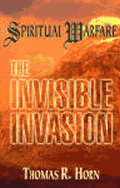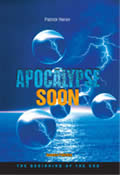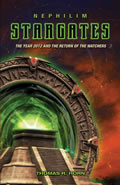PART 11
By Thomas R. Horn
October 3, 2010
NewsWithViews.com
THE COMING BATTLE... WILL BE MORE THAN ARTILECTS vs. COSMISTS
The ability to tinker with our genes offers the astounding promise—and peril—of immortality, which mythically has been the defining difference between gods and mortals. It also offers the possibility of an even greater variety of breeds of humans than there is of dogs. —Joel Garreau, Radical Evolution
The prospect of building godlike creatures fills me with a sense of religious awe that goes to the very depth of my soul and motivates me powerfully to continue, despite the possible horrible negative consequences. —Prof. Hugo de Garis, artificial brain designer

In recent years, astonishing technological developments have pushed the frontiers of humanity toward far-reaching morphological transformation that promises in the very near future to redefine what it means to be human. An international, intellectual, and fast-growing cultural movement known as transhumanism, whose vision is supported by a growing list of U.S. military advisors, bioethicists, law professors, and academics, intends the use of genetics, robotics, artificial intelligence and nanotechnology (Grin technologies) as tools that will radically redesign our minds, our memories, our physiology, our offspring, and even perhaps— as Joel Garreau, in his bestselling book Radical Evolution, claims—our very souls.
Unfortunately for mankind, the technological and cultural shift now underway not only unapologetically forecasts a future dominated by a new species of unrecognizably superior humans, but an unfathomable war—both physical and spiritual—that the world is not prepared for. It will be fought on land, within the air and sea, and in dimensions as yet incomprehensible. Even now, the synthetic forces that will plot man’s wholesale annihilation are quietly under design in leading laboratories, public and private, funded by the most advanced nations on earth, including the official governments of the United States, France, Britain, Australia, and China, to name a few. As a result of progressive deduction, reasoning, and problem solving in fields of neurotechnology and cybernetics, strong artificial intelligence or “artilects” will emerge from this research, godlike, massively intelligent machines that are “trillions of trillions of times smarter than humans” and whose rise will prove profoundly disruptive to human culture, leading to a stark division between philosophical, ideological, and political groups who either support the newly evolved life forms as the next step in human and technological evolution or who view this vastly superior intellect as an incalculable risk and deadly threat to the future of humanity. These diametrically opposed worldviews will ultimately result in a preemptive new world war—what is already being described as gigadeath, the bloodiest battle in history with billions of deaths before the end of the twenty-first century.
For those who find the fantastic elements in the statements above implicative of science fiction or even future Armageddon as forecast in the ancient apocalyptic and prophetic books of the Bible, the catastrophic vision is actually derived from near-future scenarios, which leading scientists like Prof. Hugo de Garis, director of the Artificial Brain Lab at Xiamen University in China, outlines in his book, The Artilect War: Cosmists vs. Terrans: A Bitter Controversy Concerning Whether Humanity Should Build Godlike Massively Intelligent Machines, as unfolding due to exponential growth and development this century in grin technologies.
“I believe that the twenty-first century will be dominated by the question as to whether humanity should or should not build artilects, i.e., machines of godlike intelligence,” de Garis says. “I see humanity splitting into two major political groups, which in time will become increasingly bitterly opposed, as the artilect issue becomes more real.”
Professor de Garis continues:
The human group in favor of building artilects, I label the “Cosmists” [to whom] building artilects will be like a religion... something truly magnificent and worthy of worship...
The second human group, opposed to the building of artilects, I label the “Terrans”... who will argue that allowing the Cosmists to build [artilects] implies accepting the risk, that one day, the artilects might decide... that the human species is a pest. Since the artilects would be so vastly superior to human beings in intelligence, it would be easy for [them] to exterminate the human species....
Thus to the Terrans, the Cosmists are... far worse than the regimes of Hitler, Stalin, Mao... or any other regime that murdered tens of millions of people in the twentieth century, because [this] time... we are talking about the potential annihilation of the whole human species, billions of people.[1]
Professor
de Garis continues in his book to describe how the work to build artilects
is proceeding nonetheless with anticipation of its realization potentially
close at hand. As a result, he falls asleep at night thinking about the
godlike synthetic intelligence he and  others
are constructing. Sometimes his mind becomes enraptured of his creations
with a sense of intellectual and spiritual awe. Then, waking up a few
hours later in a cold sweat, he is jolted from bed by a horrific dream
in which vivid scenes depict the slaughter of his descendents at the hands
of the artificial deities.
others
are constructing. Sometimes his mind becomes enraptured of his creations
with a sense of intellectual and spiritual awe. Then, waking up a few
hours later in a cold sweat, he is jolted from bed by a horrific dream
in which vivid scenes depict the slaughter of his descendents at the hands
of the artificial deities.
Dr. de Garis is not alone in this fear, that what he and other research scientists are feverishly working toward could soon become a nightmarish predicament mankind will not survive. Because it is difficult, if not impossible, to accurately predict how strong artificial intelligence will actually affect the world, it is unclear whether humans will be viewed by the unnatural life forms as serving a purpose in a world dominated by super-intelligent machines or whether they will be weighed as lacking any practical function and therefore be considered expendable. It could be that we won’t even see the question coming. In other words, we may already be in the process of being lulled into subservience toward the rise of the machines. As the brilliantly insane Theodore Kaczynski, in his thirty-five-thousand-word paper, “Industrial Society and Its Future” (also called the “Unabomber Manifesto”), wrote:
As society and the problems that face it become more and more complex and machines become more and more intelligent, people will let machines make more of their decisions for them, simply because machine-made decisions will bring better result than man-made ones. Eventually a stage may be reached at which the decisions necessary to keep the system running will be so complex that human beings will be incapable of making them intelligently. At that stage, the machines will be in effective control. People won’t be able to just turn the machines off, because they will be so dependent on them that turning them off would amount to suicide.[2]
Crazy or not, Kaczynski may be right in that man’s demise at the hands of machines will happen gradually, during which time we humans will become the proverbial frogs in the kettle set to boil. On the other hand, we are more likely to be reduced any day now in the blink of an enhanced eye to the status of domestic animals in the minds of artificial intelligence, as Technological Singularity—that magical future moment that many futurists and tech experts believe could happen soon—gives birth overnight to some version of the artilects, who suddenly come online as conscious, living super-minds, immensely more powerful than human beings.
“As a metaphor for mind-boggling social change, the Singularity has been borrowed from math and physics,” writes Joel Garreau in Radical Evolution. “In those realms, singularities are the point where everything stops making sense. In math it is a point where you are dividing through by zero [and in physics it is] black holes—points in space so dense that even light cannot escape their horrible gravity. If you were to approach one in a spaceship, you would find that even the laws of physics no longer seemed to function. That’s what a Singularity is like.”[3] Ray Kurzweil, who is credited with groundbreaking work in artificial intelligence and is, among other things, the co-founder of an interdisciplinary graduate studies program backed by Nasa known as the Singularity University, appreciates the comparison between the coming Technological Singularity and the physics of black holes:
Just as a black hole in space dramatically alters the patterns of matter and energy accelerating toward its event horizon, the impending Singularity in our future is [a] period during which the pace of technological change will be so rapid, its impact so deep, that human life will be irreversibly transformed.... The key idea underlying the impending Singularity is that the rate of change of our human-created technology is accelerating and its powers are expanding at an exponential pace. Exponential growth is deceptive. It starts out almost imperceptibly and then explodes with unexpected fury.[4]
In plain language, Abou Farman says Kurzweil’s work on the Singularity:
...analyzes the curve of technological development from humble flint-knapping to the zippy microchip. The curve he draws rises exponentially, and we are sitting right on the elbow, which means very suddenly this trend toward smaller and smarter technologies will yield greater-than-human machine intelligence. That sort of superintelligence will proliferate not by self-replication, but by building other agents with even greater intelligence than itself, which will in turn build more superior agents. The result will be an “intelligence explosion” so fast and so vast that the laws and certainties with which we are familiar will no longer apply. That event-horizon is called the Singularity.[5]
Kurzweil elaborates on what the Singularity will mean to human biology:
Our version 1.0 biological bodies are... frail and subject to a myriad of failure modes.... The Singularity will allow us to transcend these limitations.... We will gain power over our fates. Our mortality will be in our own hands [and] the nonbiological portion of our intelligence will be trillions of trillions of times more powerful than unaided human intelligence.
We are now in the early stages of this transition. The acceleration of paradigm shift... as well as the exponential growth of the capacity of information technology are both beginning to reach the “knee of the curve,” which is the stage at which an exponential trend becomes noticeable. Shortly after this stage, the trend becomes explosive. [Soon] the growth rates of our technology—which will be indistinguishable from ourselves—will be so steep as to appear essentially vertical.... That, at least, will be the perspective of unenhanced biological humanity.
| Subscribe to the NewsWithViews Daily News Alerts! |
The Singularity will represent the culmination of the merger of our biological thinking and existence with our technology, resulting in a world that... transcends our biological roots. There will be no distinction, post-Singularity, between human and machine.[6]
In the next entry readers will learn how critical thinking about the timing of the Singularity concerning the emergence of strong artificial intelligence and its impact on human biology is poised to take a major step forward, sooner than most comprehend.
WATCH THE TRAILER! WARNING: NOT FOR THE WEAK!
[Editor's note: This series is based on research contained in Tom and Nita Horn's upcoming new book: Forbidden Gates: How Genetics, Robotics, Artificial Intelligence, Synthetic Biology, Nanotechnology, & Human Enhancement Herald the Dawn of Techno-Dimensional Spiritual Warfare.]
Sign up to be notified when the book on which this series is based is released and receive OVER $60.00 IN FREE GIFTS! Sign up here!
Click here for part -----> 1, 2, 3, 4, 5, 6, 7, 8, 9, 10, 11,
Footnotes:
1,
Hugo de Garis, The Artilect War: Cosmists vs. Terrans: A Bitter Controversy
Concerning Whether Humanity Should Build Godlike Massively Intelligent
Machines E(Palm Springs, CA: ETC, 2005) 11–12, 15, 84.
2,
Theodore Kaczynski, “Industrial
Society and Its Future,” Wikisource.
3,
Joe Garreau, Radical Evolution: The Promise and Peril of Enhancing
Our Minds, Our Bodies—and What It Means to Be Human (New York:
Broadway, 2005) 71–72)
4,
Ray Kurzweil, The Singularity is Near (New York: Penguin, 2006)
7–8.
5,
Abou Farman, “The
Intelligent Universe,” Maison Neuve (8/ 2/10)
6,
Kurzweil, 9.
� 2010 Thomas Horn - All Rights Reserved
Sign
Up For Free E-Mail Alerts
E-Mails are used strictly for
NWVs alerts, not for sale
Thomas Horn is the CEO of RaidersNewsNetwork.com and SurvivorMall.com.
Over the last decade, he has authored three books, wrote dozens of published editorials, and had several feature magazine articles. In addition to past articles at NewsWithViews.com , his works have been referred to by writers of the LA Times Syndicate, MSNBC, Christianity Today, Coast to Coast, World Net Daily, White House Correspondents and dozens of newsmagazines and press agencies around the globe. Tom's latest book is "The Ahriman Gate," which fictionalizes the use of biotechnology to resurrect Biblical Nephilim.
Thomas is also a well known radio personality who has guest-hosted and appeared on dozens of radio and television shows over the last 30 years, including "The 700 Club" and "Coast to Coast AM." When looking for a spokesperson to promote their film "Deceived" staring Louis Gossett Jr. and Judd Nelson, "Cloud 10 Pictures" selected Thomas as their spokesperson to explain the Christian viewpoint on UFO-related demonology.
Web Site: RaidersNewsNetwork.com
E-Mail: RaidersNewsUpdate@gmail.com














 Share
This Article
Share
This Article








